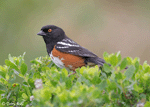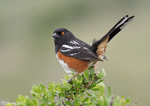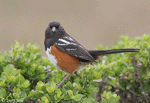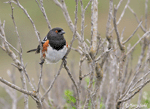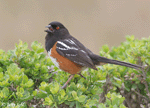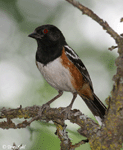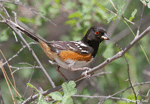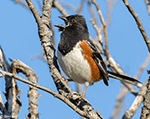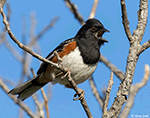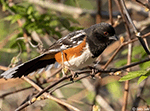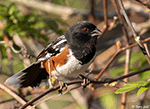Spotted Towhee
Pipilo maculatus
| Length: 7 inches | Wingspan: 10.5 inches | Seasonality: Summer / Migrant |
| ID Keys: Black upperparts with white spots, black hood, rufous sides, white underparts, red eye. Compare to similar Eastern Towhee, which lacks spots. | ||
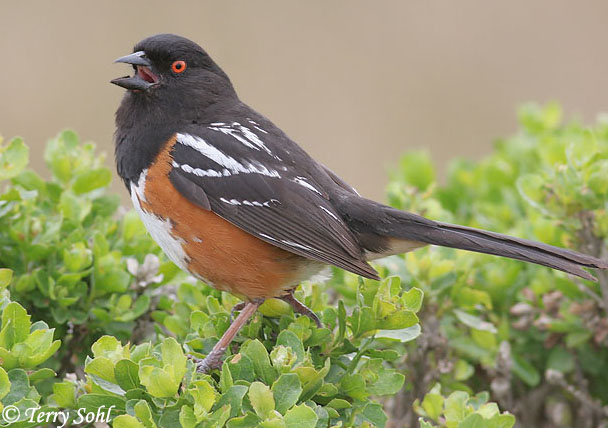 The Spotted Towhee and the Eastern
Towhee were formerly considered separate races of the same species, the
Rufous-Sided Towhee (a name which is no longer used). The two are very
similar, but differ in range, as the Spotted Towhee is mostly a western U.S.
bird while the Eastern Towhee is an eastern
U.S. bird. The Eastern Towhee also
lacks the Spotted Towhee's white spots on its back and wings. The two
species may interbreed where their ranges overlap, including in South Dakota. In
some areas such as Newton Hills State
Park in far southeastern South Dakota, both species can be found during the
summer breeding season. With both birds found in such close proximity, even the
songs of the two species become intermixed, with one species learning to sing
the song of the other species.
The Spotted Towhee and the Eastern
Towhee were formerly considered separate races of the same species, the
Rufous-Sided Towhee (a name which is no longer used). The two are very
similar, but differ in range, as the Spotted Towhee is mostly a western U.S.
bird while the Eastern Towhee is an eastern
U.S. bird. The Eastern Towhee also
lacks the Spotted Towhee's white spots on its back and wings. The two
species may interbreed where their ranges overlap, including in South Dakota. In
some areas such as Newton Hills State
Park in far southeastern South Dakota, both species can be found during the
summer breeding season. With both birds found in such close proximity, even the
songs of the two species become intermixed, with one species learning to sing
the song of the other species.
Habitat:
Prefers brush and thickets, which may include woodland understory, forest edges, shelterbelts and fencelines, riparian areas, or other areas with dense vegetation for nesting.
Diet:
Insects, fruits and berries, seeds, nuts, occasionally small reptiles, amphibians, and snakes.
Behavior:
Does most of its foraging on the ground, often scratching through leaf litter in search of insects and other food. They will also forages low in trees or in the forest undergrowth.
Nesting:
June and July in South Dakota. The nest of a Spotted Towhee is placed on the ground or close to the ground, typically next to the base of a shrub, a clump of grass, or other similarly protected location. The nest is a cup of twigs, leaves, and strips of bark, lined with finer material such as fine grasses, hair, bits of moss or lichen, and small rootlets. The female lays between 2 and 6 eggs, and she alone incubates them. The young hatch after about 12-14 days, and fledge from the nest after a similar number of days after hatching.
Song:
The song of a Spotted Towhee is kind of a poor man's version of the Eastern Towhee's famous "Drink Your Tea" song, although it typically skips the middle syllable. Sometimes the song may skip both of the first syllables, and consist solely of the trilling ending. Calls of a Spotted Towhee include a cat-like mewing and other vocalizations..
1Click here to hear the song of a Spotted Towhee
2Click here to hear the cat-like mewing call of a Spotted Towhee
Migration:
Some to the south and west of South Dakota may be permanent residents, but South Dakota birds migrate south in the fall.
Interactive eBird map:
Click here to access an interactive eBird map of Spotted Towhee sightings
Bird Feeders:
Will attend for a cracked corn, peanuts, suet, sunflower seeds, and other commercially offered seed mixtures.
Similar Species:
Not surprisingly, since they were once considered the same species, the Spotted Towhee is quite similar overall to the Eastern Towhee.
- Eastern Towhee - Very similar in overall structure and plumage, the only readily apparent difference from a Spotted Towhee is that Eastern Towhees are more of a solid black on their upper parts and upper wing, lacking the white spots found on a Spotted Towhee. The songs of the two species are generally considered distinct, but in an area such as South Dakota where both species may sometimes be found, the two species have sometimes learned to sing the songs of the other species, so voice alone cannot be used to identify an unseen bird.
Conservation Status:
Widespread and common in many parts of its range, with populations that are considered stable. The IUCN considers the Spotted Towhee to be a species of "Least Concern".
South Dakota Hotspot:
Common in the western part of the state, but in the eastern part of the state, Newton Hills State Park in Lincoln County (southeastern corner of South Dakota) is an excellent spot to look for both Spotted and Eastern Towhees in the summer.
Further Information:
3) Audubon Guide - Spotted Towhee
Photo Information:
April 19th, 2007 - Point Reyes National Seashore, California - Terry Sohl
Additional Photos:
Click on the image chips or text links below for additional, higher-resolution Spotted Towhee photos.
Audio File Credits:
1Richard E. Webster - Recorded in Sonora, Mexico on July 29th, 2019. Original recording and information from xeno-canto.
2Barry Edmonston - Recorded near Vancouver, British Columbia on March 19th, 2020. Original recording and information from xeno-canto.
| Click on the map below for a higher-resolution view |
 |
| South Dakota Status: Common summer resident in the western part of the state. Uncommon migrant in the east, and an uncommon summer resident in the far southeastern part of the state. |
Additional Spotted Towhee Photos
Click for a higher-resolution version of these photos
